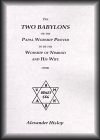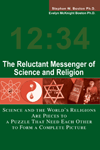
Introduction
Preface Second Ed.
Preface Third Ed.
Note by the Editor
The Two Systems
Trinity in Unity
Mother and Child
The Child in Assyria
The Child in Egypt
The Child in Greece
Death of the Child
Deification of the Child
Mother of the Child
Christmas
Easter
Nativity of John
Feast of thr Assumption
Baptismal Regeneration
Justification by Works
Sacrifice of the Mass
Extreme Unction
Purgatory and Prayers for the Dead.
Idol Processions
Relic Worship.
Clothing and Crowning of Images.
The Rosary
Lamps & Wax-candles
Sign of the Cross
Sovereign Pontiff
Priests, Monks, and Nuns.
Great Red Dragon
Beast From the Sea
Beast from the Earth
Image of the Beast
Number of the Beast
Invisible Head of the Papacy
Woman with Golden Cup
Hebrew Chronology
Shing Moo and Ma Tsoopo of China.
Ala-Mahozim
Meaning of the name Centaurus
Olenos, the Sin-Bearer
Identification of Rhea or Cybele and Venus
Virgin Mother of Paganism
Goddess Mother as a Habitation.
Meaning of the name Astarte.
Oannes and Souro
The Identity of the Scandinavian Odin and Adon of Babylon
Stripping of the Clothes of the Initiated in the Mysteries
Zoroaster, the Head of the Fire-Worshippers
Story of Phaethon
Roman Imperial Standard of the Dragon of Symbol of Fire-worship
The Slaying of the Witness
Attes, the Sinner
Click here for The Reluctant Messenger (Host Site)
CHAPTER I.
DISTINCTIVE CHARACTER OF THE TWO SYSTEMS.
In leading proof of the Babylonian character of the Papal Church the first point to which I solicit the reader's attention, is the character of Mystery which attaches alike to the modern Roman and the ancient Babylonian systems. The gigantic system of moral corruption and idolatry described in this passage under the emblem of a woman with a "GOLDEN CUP IN HER HAND" (Rev.xvii.4), "making all nations DRUNK with the wine of her fornication" (Rev. xvii. 2; xviii. 3), is divinely called "MYSTERY, Babylon the Great" (Rev. xvii. 5). That Paul's "MYSTERY of iniquity," as described in 2 Thess. ii. 7, has its counterpart in the Church of Rome, no man of candid mind, who has carefully examined the subject, can easily doubt. Such was the impression made by that account on the mind of the great Sir Matthew Hale, no mean judge of evidence, that he used to say, that if the apostolic description were inserted in the public "Hue and Cry" any constable in the realm would be warranted in seizing, wherever he found him, the Bishop of Rome as the head of that "MYSTERY of iniquity." Now, as the system here described is equally characterised by the name of "MYSTERY," it may be presumed that both passages refer to the same system. But the language applied to the New Testament Babylon, as the reader cannot fail to see, naturally leads us back to the Babylon of the ancient world. As the Apocalyptic woman has in her hand a CUP, wherewith she intoxicates the nations, so was it with the Babylon of old. Of that Babylon, while in all its g lory, the Lord thus spake, in denouncing its doom by the prophet Jeremiah: "Babylon hath been a GOLDEN CUP in the Lord's hand, that made all the earth drunken: the nations have drunken of her wine; therefore the nations are mad" (Jer. li. 7). Why this exact similarity of language in regard to the two systems? The natural inference surely is, that the one stands to the other in the relation of type and antitype. Now, as the Babylon of the Apocalypse is characterised by the name of "MYSTERY," so the grand dis tinguishing feature of the ancient Babylonian system was the Chaldean "MYSTERIES," that formed so essential a part of that system. And to these mysteries, the very language of the Hebrew prophet, symbolical though of course it is, distinctly alludes, when he speaks of Babylon as a "golden CUP." To drink of "mysterious beverages," says Salverte, was indispensable on the part of all who sought initiation in these Mysteries. * These "mysterious beverages" were composed of "wine, honey, water, and flour." * From the ingredients avowedly used, and from the nature of others not avowed, but certainly used, * there can be no doubt that they were of an intoxicating nature; and till the aspirants had come under their power, till their understandings had been dimmed, and their passions excited by the medicated draught, they were not duly prepared for what they were either to hear or to see. If it be inqui red what was the object and design of these ancient "Mysteries," it will be found that there was a wonderful analogy between them and that "Mystery of iniquity" which was embodied in the Church of Rome. Their primary object was to introduce privately, by little and little, under the seal of secrecy and the sanction of an oath, what it would not have been safe all at once and openly to propound. The time at which they were instituted proves that this must have been the case. The Chaldean Mysteries can be traced up to the days of Semiramis, who lived only a few centuries after the flood, and who is known to have impressed upon them the image of her own depraved and polluted mind. * That beautiful but abandoned queen of Babylon was not only herself a paragon of unbridled lust and licentiousness, but in the Mysteries which she had a chief hand in forming, she was worshipped as Rhea, * the great "MOTHER" of the gods, * * with such atrocious rites as identified her with Venus, the MOTHER of all impurity, and raised the very city where she had reigned to a bad eminence among the nations, as the grand seat at once of idolatry and consecrated prostitution. * Thus seat was this Chaldean queen a fit and remarkable prototype of the "Woman" in the Apocalypse, with the golden cup in her hand, and the name on her forehead, "Mystery, Babylon the Great, the MOTHER of harlots and abominations of the earth." The Apocalyptic emblem of the Harlot woman with the cup in her hand was even embodied in the symbols of idolatry derived from ancient Babylon, as they were exhibited in Greece; for thus was the Greek Venus originally represented, * and it is singular that in our own day, and so far as appears for the first time, the Roman Church has actually taken this very symbol as her own chosen emblem. In 1825, on the occasion of the jubilee, Pope Leo XII. struck a medal, bearing on the one side his won image, and on the other, that of the Church of Rome symbolised as a "Woman," holding in her left hand a cross, and in her right a CUP, with the legend around her, "Sedet super universum," "The whole world is her seat." * Now the period when Semiramis lived,--a period when the patriarchal faith was still fresh in the minds of men, when Shem was still alive, * to rouse the minds of the faithful to rally around the banner for the truth and cause of God, made it hazardous all at once and publicly to set up such a system as was inaugurated by the Babylonian queen, We know, from the statements in Job, that among patriarchal tribes that had nothing whatever to do with Mosaic institutions, but which adhered to the pure faith of the patriarchs, idolatry in any shape was held to be a crime, to be visited with signal and summary punishment on the heads of those who practised it. "If I beheld the sun," said Job, "when it shined, or the moon walking in brightness; and my heart hath been secretly enticed, and * my mouth hath kissed my hand; this also were an iniquity to be punished by the judge; for I should have denied the God that is above" (Job xxxi. 26-28). Now if this was the case in Job's day, much more must it have been the case at the earlier period when the Mysteries were instituted. It was a matter, therefore, of necessity, of idolatry where to be brought in, and especially such a foul idolatry as the Babylonian system contained in its bosom, that it should be done stealthily and in secret. * Even though introduced by the hand of power, it might have produced a revulsion, and violent attempts might have been made b y the uncorrupted portion of mankind to put it down; and at all events, if it had appeared at once in all its hideousness, it would have alarmed the consciences of men, and defeated the very object in view. That object was to bind all mankind in blind and absolute submission to a hierarchy entirely dependent on the sovereigns of Babylon. In the carrying out of this scheme, all knowledge, sacred and profane, came to be monopolised by the priesthood, * who dealt it out to those who were initiated in the "Mysteries" exactly as they saw fit, according as the interests of the grand system of spiritual despotism they had to administer might seem to require. Thus the people, wherever the Babylonian system spread, where bound neck and heel to the priests. The priest were the only depositaries of religious knowledge; they only had the true tradition, by which the writs and symbols of the public religion could be interpreted; and without blind and implicit submission to them, what was necessary for salvation could not be known. Now compare this with the early history of the Papacy, and with its spirit and modus operandi throughout, and how exact was the coincidence! Was it in a period of patriarchal light that the corrupt system of the Babylonian "Mysteries" began? It was in a period of still greater light that that unholy and unscriptural system commenced, that has found such a rank development in the Church of Rome. It began in the very age of the apostles, when the primitive Church was in its flower, when the glorious fruits of Pentecost were everywhere to be seen, when martyrs were sealing their testimony for the truth with their blood. Even then, when the Gospel shone so brightly, the Spirit of God bore this clear and distinct testimony by Paul: "THE MYSTERY OF INIQUITY DOTH ALREADY WORK" (2 Thess. ii. 7). That system of iniquity which then began it was divinely foretold was to issue in a portentous apostacy, that in due time would be awfully "revealed," and would continue until it should be destroyed "by the breath of the Lord's mouth, and consumed by the brightness of His coming" (Ibid. v. 8). But at its first introduction into the Church, it came in secretly and by stealth, with "all DECEIVABLENESS of unrighteousness." It wrought "mysteriously" under fair but false pretences, leading men away from the simplicity of the truth as it is in Jesus. And it did so secretly, for the very same reason that idolatry was secretly introduced in the ancient Mysteries of Babylon; it was not safe, it was not prudent to do otherwise. The zeal of the true Church, though destitute of civil power, would have aroused itself, to put the false system and all its abettors beyond the pale of Christianity, if it had appeared openly and all at once in all its grossness; and this would have arrested its progress. Ther efore it was brought in secretly, and by little and little, one corruption being introduced after another, as apostacy proceeded, and the backsliding Church became prepared to tolerate it, till it has reached the gigantic height we now see, when in most every particular the system of the Papacy is the very antipodes of the system of the primitive Church. Of the gradual introduction of all that is now most characteristic of Rome, through the working of the "Mystery of iniquity," we have very striking evidence, preserved even by Rome itself, in the inscriptions copied from the Roman catacombs. These catacombs are extensive excavations underground in the neighbourhood of Rome, in which the Christians, in times of persecution during the first three centuries, celebrated their worship, and also buried their dead. On some of the tombstones there are inscriptions still to be found, which are directly in the teeth of the now well-known principles and practices of Rome. Take only one example: What, for instance, at this day is a more distinguishing mark of the Papacy than the enforced celibacy of the clergy? Yet from these inscriptions we have most decisive evidence, that even in Rome, there was a time when no such system of clerical celibacy was known. Witness the following, found on different tombs:--
1. "To Basilius, the presbyter, and Felicitas, his wife. They made this for themselves."
2. "Petronia, a priest's wife, the type of modesty. In this place I lay my bones. Spare your tears, dear husband and daughter, and believe that it is forbidden to weep for one who lives in God." * A prayer here and there for the dead: "May God refresh thy spirit," proves that even then the Mystery of iniquity had begun to work; but inscriptions such as the above equally show that it had been slowly and cautiously working,--that up to the period to which they refer, the Roman Church had not proceeded the l ength it had done now, of absolutely "forbidding its priests to 'marry.' " Craftily and gradually did Rome lay the foundation of its system of priest-craft, on which it was afterwards to rear so vast a superstructure. At its commencement, "Mystery" was stamped upon its system.
But this feature of "Mystery" has adhered to it throughout its whole course. When it had once succeeded in dimming the light of the Gospel, obscuring the fulness and freeness of the grace of God, and drawing away the souls of men from direct and immediate dealings with the One Grand Prophet and High Priest of our profession, a mysterious power was attributed to the clergy, which gave them "dominion over the faith" of the people--a dominion directly disclaimed by apostolic men (2 Cor. i. 24), but which, in connection with the confessional, has become at least as absolute and complete as was ever possessed by Babylonian priest over those initiated in the ancient Mysteries. The clerical power of the Roman priesthood culminated in the erection of the confessional. That confessional was itself borrowed from Babylon. The confession required of the votaries of Rome is entirely different from the confession prescribed in the Word of God. The dictate of Scripture in regard to confession is, "Confess your faults one to another" (James v. 16), which implies that the priest should confess to the people, as well as the people to the priest, if either should sin against the other. This could never have served any purpose of spiritual despotism; and therefore, Rome, leaving the Word of God, has had recourse to the Babylonian system. In that system, secret confession to the priest, according to a prescribed form, was required of all who were admitted to the "Mysteries;" and till such confession had been made, no complete ini tiation could take place. Thus does Salverte refer to this confession as observed in Greece, in rites that can be clearly traced to a Babylonian origin: * the Greeks, from Delphi to Thermopylae, were initiated in the Mysteries of the temple of Delphi. Their silence in regard to everything they were commanded to keep secret was secured both by the fear of the penalties threatened to a perjured revelation, and by the general CONFESSION exacted of the aspirants after initiation--a confession which caused them greater dread of the indiscretion of the priest, than have him reason to dread their indiscretion. * This confession is also referred to by Potter, in his "Greek Antiquities," though it has been generally overlooked. In his account of the Eleusinian mysteries, after describing the preliminary ceremonies and instructions before the admission of the candidates for initiation into the immediate presence of the divinities, he thus proceeds:--"Then the priest that initiated them called "Hierophantes" {the Hiero phant}, proposed certain QUESTIONS, as, whether they were fasting, etc., to which they returned answers in a set form." * The etcetera here might not strike a casual reader; but it is a pregnant etcetera, and contains a great deal. It means, Are you free from every violation of chastity? and that not merely in the sense of moral impurity, but in that factitious sense of chastity which Paganism always cherishes. * Are you free from the guilt of murder?--for no one guilty of slaughter, even accidentally, could be admitted till he was purged from blood, and there were certain priests, called Koes, who "heard confessions" in such cases, and purged the guilt away. * The strictness of the inquiries in the Pagan confessional is evidently implied in certain licentious poems of Propertius, Tibullus, and Juvenal. * Wilkinson, in his chapter on "Private Fast and Penance," which, he says, "were strictly enforced," in connection with "certain regulations at fixed periods," * has several classical quotations, which clearly prove whence Popery derived the kind of questions which have stamped that character of obscenity on its confessional, as exhibited in the notorious pages of Peter Dens. The pretence under which this auricular confession was required, was, that the solemnities to which the initiated were to be admitte d were so high, so heavenly, so holy, that no man with guilt lying on his conscience, and sin unpurged, could lawfully be admitted to them. For the safety, therefore, of those who were to be initiated, it was held to be indispensable that the officiating priest should thoroughly probe their consciences, lest coming without due purgation from previous guilt contracted, the wrath of the gods should be provoked against the profane intruders. This was the pretence; but when we know the essentially unholy nature, both of the gods and their worship, who can fail to see that this was nothing more than a pretence; that the grand object in requiring the candidates for initiation to make confession to the priest of all their secret faults and short comings and sins, was just to put them entirely in the power of those to whom the inmost feelings of their souls and their most important secrets were confided? Now, exactly in the same way, and for the very same purposes, has Rome erected the confessional. Instead of requir ing priests and people alike, as the Scripture does, to "confess their faults one to another," when either have offended the other, it commands all, on pain of perdition, to confess to the priest, * whether they have transgressed against him or no, while the priest is under no obligation to confess to the people at all. Without such confession, in the Church of Rome, there can be no admission to the Sacraments, any more than in the days of Paganism there could be admission without confession to the benefit of the Mysteries. Now, this confession is made by every individual, in SECRECY AND IN SOLITUDE, to the priest sitting in the name and clothed with the authority of God, * invested with the power to examine the conscience, to judge the life, to absolve or condemn according to his mere arbitrary will and pleasure. This is the grand pivot on which the whole "Mystery of iniquity," as embodied in the Papacy, is made to turn; and wherever it is submitted to, admirably does it serve the design of binding men in abject subjection to the priesthood.
In conformity with the principle out of which the confessional grew, the Church, that is, the clergy, claimed to be the sole depositaries of the true faith of Christianity. As the Chaldean priests were believed alone to possess the key to the understanding of the Mythology of Babylon, a key handed down to them from primeval antiquity, so the priests of Rome set up to be the sole interpreters of Scripture; they only had the true tradition, transmitted from age to age, without which it was impossible to arr ive at its true meaning. They, therefore, require implicit faith in their dogmas; all men were bound to believe as the Church believed, while the Church in this way could shape its faith as it pleased. As possessing supreme authority, also, over the faith, they could let out little or much, as they judged most expedient; and "RESERVE" in teaching the great truths of religion was as essential a principle in the system of Babylon, as it is in Romanism or Tractarianism at this day. * It was this priestly claim to dominion over the faith of men, that "imprisoned the truth in unrighteousness" * in the ancient world, so that "darkness covered the earth, and gross darkness the people." It was the very same claim, in the hands of the Roman priests, that ushered in the dark ages, when, through many a dreary century, the Gospel was unknown, and the Bible a sealed book to millions who bore the name of Christ. In every respect, then, we see how justly Rome bears on its forehead in the name, "Mystery, Babylon the Great."
Previous | Next

or The Papal Worship Proved to be the Worship of Nimrod and His Wife
$3.99 Kindle eBook
Buy from Amazon.com
The Essential Teachings of Herbert W. Armstrong
His Teachings Focused on The Incredible Human Potential. Did He Solve the Mystery of the Ages?
New Book about HWA's Teachings. Recommended!

